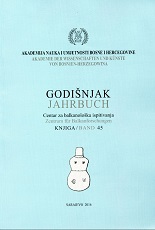Ecclesiam de Glasinac – arheološka istraživanja na Crkvini u Bjelosavljevićima
Ecclesiam de Glasinac – archaeological Excavations on the Crkvina in Bjelosavljevići
Author(s): Aleksandar Jašarević, Snježana AntićSubject(s): Archaeology, Cultural history, History of Church(es), Local History / Microhistory, Culture and social structure , 13th to 14th Centuries, 15th Century
Published by: Akademija Nauka i Umjetnosti Bosne i Hercegovine
Keywords: Glasinac; stećci – medieval tombstones; church; 14–15th century; medieval jewelry; textile;
Summary/Abstract: More than one century after the initially discovery, Glasinac is still one of the most important archaeological areas in the Balkans. Extensive research at Glasinac started in 1888, along with the establishment of the National Museum in Sarajevo. In the last few decades the main focus was on the interpretation of already existing, numerous, materials from more than thousand prehistoric tumulus. In addition to this, very small quantity of archaeological materials from historical periods have been published. Basically this has created a problem in understanding Glasinac as a region that was occupied by many different cultures and populations through, not just prehistoric but also historical periods. This paper presents results from rescue archaeological excavation from site Crkvine in Bjelosavljevići on Glasinac conducted from 2013–2014 and in 2017. The archaeological excavations discovered the remains of medieval church, decorated with frescoes, and 48 graves from the necropolis. The archeological sites is located on the elongated hill plateau, loosely connected in its western part to the neighboring massive. The plateau is oriented East-West with a clear view on Glasinac field and other known archaeological sites in surrounding. The church is dated based on architectural features in the first half of the 14th century. The object shows similarities with the churches from medieval Raška (Serbia), mostly built as a mausoleum for the nobility. During the late 14th century around the church a large necropolis is being formed, with characteristic Bosnian medieval tombstones – stećci. All the burial pits were cut into bedrock. The characteristic of this site are well-preserved wooden structures in graves. Some structural shapes are, for now, only known from this site. All deceased are buried in an extended position, oriented east-west, with a couple of exceptions. A greater number of children’s graves indicate a high mortality rate of this population in the Middle Ages. The children had a different funeral practice, buried in shallow pit near adults without tombstones. Some of the graves contained luxurious material and indicate to the high status of the deceased. This is also confirmed by the remains of luxurious textiles, imported most probably from Dubrovnik.
Journal: Godišnjak Centra za balkanološka ispitivanja
- Issue Year: 2017
- Issue No: 46
- Page Range: 225-256
- Page Count: 32
- Language: Bosnian

